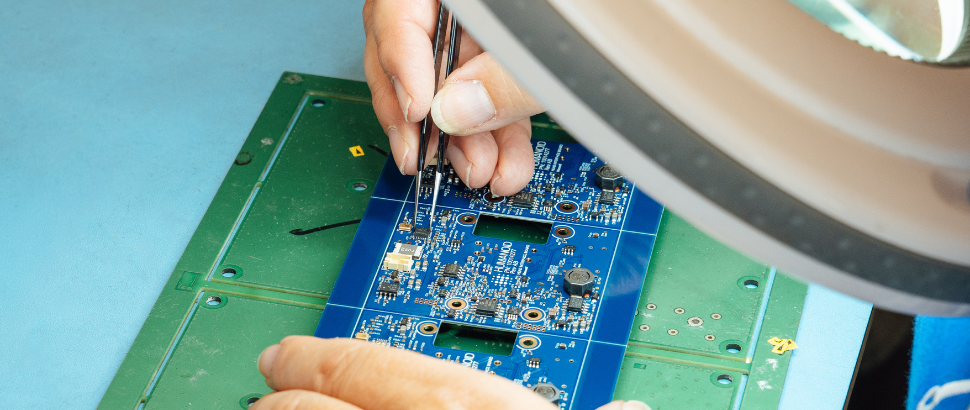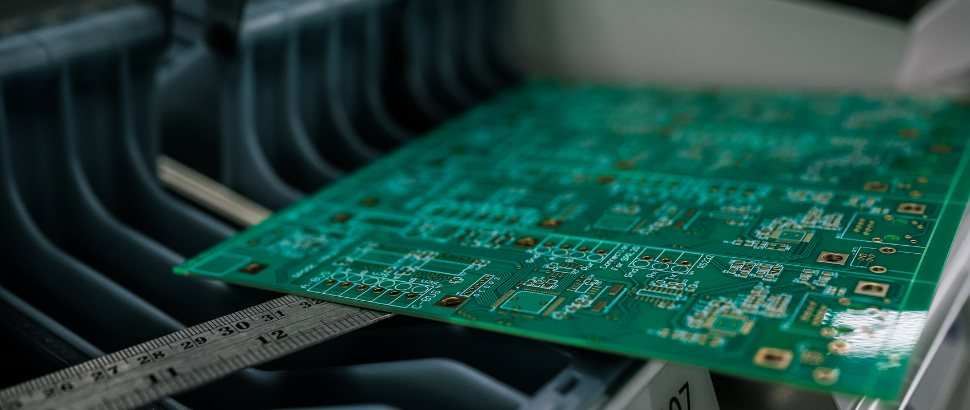News, Blogs & Articles
.png)
How to overcome the global semiconductor shortage
Case Study
October 3, 2022
Semiconductors, sometimes also known as integrated circuits (ICs) or microchips, are materials that have specific electrical properties that sit between a conductor and insulator, hence the name semiconductor.
Generally, semiconductors are made from silicon, germanium or gallium arsenide. Under a process named ‘doping’, impurities are added to these elements causing changes in the conductivity of the material. Semiconductors have a unique structure that allows their conductivity to be controlled by stimulation from light, electric currents and electromagnetic fields. Their ability to exist in between a conductor and an insulator means that under certain temperatures they have the ability to switch between the two, making it an extremely useful and flexible component. These unique properties of a semi-conductor make it an integral component for electronic devices in a huge range of industries including medical, transportation and the military.
The global semiconductor shortage: when did it happen and why?
In recent years there has been an issue with the supply and demand of semiconductors across the industry. Historically, there have been several semiconductor shortages, however, the most recent shortage began in March 2020, at the start of the pandemic. The shortage has been global, but hasa particularly affecting the Americas and Europe.
The COVID-19 pandemic affected businesses and industries across the globe, with travel, transport and retail closed for a significant period of time. As countries across Europe and America headed in and out of various lockdowns and hit peaks of infections at different times, this affected the demand and supply across the globe and thus lead to a global semiconductor shortage.
As businesses were forced to close, and people were told to work from home, there was a huge influx in companies, and individuals purchasing new tech equipment to help kit out their ‘WFH’ offices. With pubs, restaurants and entertainment closed and little to do, supply for gaming equipment also surged and companies could not keep up with production. However, when other industries such as automotive suffered, with a lack of demand from consumers searching for new cars, they needed to pause their production and thus their own need for semiconductors.
These inconsistencies in the market and the sudden surges and pausing in production across various industries, created a huge issue in the supply chain.
Semiconductor shortage update:
There has been much speculation in the industry on how long the semiconductor chip shortage will last. Some sources state that after analysing trends and data, they believe the global semiconductor shortage could last the next three to five years, particularly for certain technology nodes. A technology node refers to a specific semiconductor manufacturing process and its design rules. Certain semiconductor nodes, such as those used within the automotive industry, are likely to be affected the longest due to the huge surge in demand for semiconductors during the pandemic for phones, tablets and other devices, which surpassed the available supply. As we come out the other side of the pandemic, and demand for cars and vehicles has increased, this has the automotive industry in a precarious position as they cannot keep up with the newly increased demand.
The conflict between Russia and Ukraine has further intensified the on-going issue, as Ukraine supplies 25 to 35% of the world’s purified neon gas, and Russia supplies 25 to 30 percent of palladium, a rare metal used for semiconductors.
Whilst this semiconductor shortage update may seem doom and gloom with the full effects potentially lasting into 2023 and beyond, there is some good news: the global semiconductor shortage should see some improvements throughout 2022, with companies increasing capital expenditure in order to try and meet demand. Similarly, when the PC and phone markets begin to weaken, the demand and supply to other industries should begin to balance out.
How this semiconductor shortage has affected OEMs
We’ve already discussed how the global semiconductor shortage has affected the automotive industry, with companies such as Ford losing 20% of its production in Q1. Whilst the automotive industry seems to be the most affected, OEMs across the globe are having major issues with their supply chain, having to pause production and delay their products, which ultimately affects their revenue..
How can you overcome this semiconductor shortage and bring your product to the market?
There are predictions circulating that 50% of OEMs may start producing their own chips by 2025, in order to try and combat the shortage and gain more control over their supply chain, a solution that would help companies in both the short and long term as the global shortage slowly stabilises. However, that may not be the solution for all.
In order to help overcome the shortage and bring your product to the market, strategy and planning is key. As the shortage is likely to remain for some time, there are some solutions which can help with damage limitation:
- Expand your production capacity or look to utilise older chip technologies to help in the meantime.
- Focus on software updates, as opposed to new hardware. Products specialising in AI for example, have an opportunity to utilise new advances in smart compression to rely more on software solutions, rather than new hardware, to help bring their products to the market.
- Redesign products where possible - when a component is in short supply, companies should look to redesign, where possible, without this component
- Utilise AI to help speed up the research and development process and aid in risk assessment, thus making the supply chain more efficient and streamlined
Whilst these options don’t fully solve the issue at hand, they will help to maintain a steadier supply chain in the wake of the shortage.
For more information or support, feel free to get in touch with the friendly team at ABL Circuits who will be happy to offer any advice throughout this turbulent time. Alternatively, if you’re looking for help with design and assembly, get in touch for a quote.
News, Blogs & Articles















